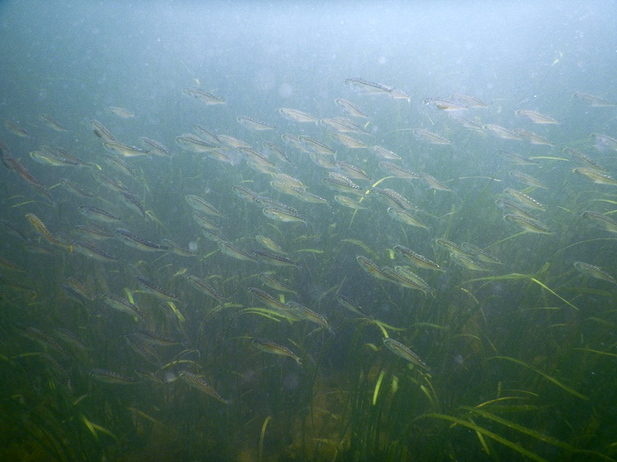Pacific sandfish • Trichodon trichodon
{Trichodon = hair-teeth}
Left: a pacific sandfish photographed by the Hakai Institute FABS (Fish Assemblage Beach Seining) team. Right: a school of Pacific sandfish — possibly juveniles — among seagrass. Photo by Carolyn Prentice.
Identification
The Pacific sandfish can be identified by its upturned face, large mouth, and distinctive brown and silver spotting along its dorsal side. This spotting stands out strongly against the rest of its body, which is silvery. It has a long anal fin, large pectoral fins, a forked tail (caudal) fin, and two dorsal fins marked with black patches. Its mouth is lined with small bristly teeth. This fish gets to 30 cm long.
Habitat & Range
This species spends most of its time buried in sand with its head poking out. It inhabits relatively shallow waters along sandy, wave-swept coastlines, from the intertidal to depths of 375 m. Juveniles may be found schooling in shallower water. This fish is found on both sides of the north Pacific: its range extends from Japan and the Kuril Islands north and east along the Aleutian Islands to Alaska, and through the Pacific Northwest south to central California.
Intriguing Info
The Pacific sandfish buries its body in sand in order to catch prey: it waits with only its head exposed until prey comes within reach, at which point it strikes. Click here to learn more about Pacific sandfish, via a study carried out by the Alaska Fisheries Science Center.
The Pacific sandfish can be identified by its upturned face, large mouth, and distinctive brown and silver spotting along its dorsal side. This spotting stands out strongly against the rest of its body, which is silvery. It has a long anal fin, large pectoral fins, a forked tail (caudal) fin, and two dorsal fins marked with black patches. Its mouth is lined with small bristly teeth. This fish gets to 30 cm long.
Habitat & Range
This species spends most of its time buried in sand with its head poking out. It inhabits relatively shallow waters along sandy, wave-swept coastlines, from the intertidal to depths of 375 m. Juveniles may be found schooling in shallower water. This fish is found on both sides of the north Pacific: its range extends from Japan and the Kuril Islands north and east along the Aleutian Islands to Alaska, and through the Pacific Northwest south to central California.
Intriguing Info
The Pacific sandfish buries its body in sand in order to catch prey: it waits with only its head exposed until prey comes within reach, at which point it strikes. Click here to learn more about Pacific sandfish, via a study carried out by the Alaska Fisheries Science Center.
References
Froese, R. and Valdestamon, R. R. Trichodon trichodon (Tilesius, 1813) Pacific sandfish. FishBase. Accessed 07/04/2016.
Hanke, G. (2014). Something you don't see every day: the Pacific Sandfish. Royal BC Museum. Accessed 07/04/2016.
Lamb, A. and Edgell, P. Coastal Fishes of the Pacific Northwest. Revised. (2010). Madeira Park, BC: Harbour Publishing. P. 89.
Authors and editors of page
Kelly Fretwell (2016).
Froese, R. and Valdestamon, R. R. Trichodon trichodon (Tilesius, 1813) Pacific sandfish. FishBase. Accessed 07/04/2016.
Hanke, G. (2014). Something you don't see every day: the Pacific Sandfish. Royal BC Museum. Accessed 07/04/2016.
Lamb, A. and Edgell, P. Coastal Fishes of the Pacific Northwest. Revised. (2010). Madeira Park, BC: Harbour Publishing. P. 89.
Authors and editors of page
Kelly Fretwell (2016).





